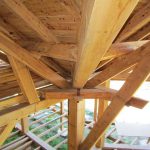Wood’s unique material properties make it one of the best choices for your build. Here, we look at 3 surprising factors that make wood nature’s gift to building
Wood is nature’s most incredible building material, unsurpassed in environmental considerations, incredibly versatile in design and its range of applications, and superior in performance for thermal, acoustic, strength and fire applications. Above all, it is inspiring, striking and ultimately beautiful; it is nature’s gift to the built environment.
The environment
It is a well-known fact that wood has significant credentials when it comes to environmental considerations. Trees absorb carbon dioxide from the atmosphere, the carbon is stored in the wood and then emitted into the atmosphere. This carbon stays locked in the timber until the timber is burnt or allowed to decay, at which point the carbon is released back into the atmosphere. While using timber for fuel is still carbon-neutral, using it for building creates a net absorption of carbon.
It makes sense to use wood for the construction of long-lived buildings (some log houses are more than 400 years old now) and store the carbon, and to actively grow more trees to absorb more carbon.
The operational energy of a building — with regards to insulation and sealing — has been the main focus for energy conservation, but as we become more proficient in building well-insulated buildings, the focus is moving towards the life cycle and embodied energy of materials. There are very few man-made materials that can compete with timber from this viewpoint as the energy to produce timber is significantly lower than materials such as aluminium, steel and concrete. It is possible to significantly reduce the embodied energy of a home by using wood, and if designed to be easily dissembled and recoverable from the building for reuse, the embodied energy can be reduced even further.
Design advantages
Wood is an incredibly versatile building material; it can be used structurally (exposed timber can be an architectural feature), or it can be used decoratively for lining, cladding, flooring, trims, mouldings, landscaping and much more. There is something about wood that seems to affect our senses; it is warm, rich, inviting, soothing, and creates an ambience that no other building material can imitate. Not to mention that it is a real eye-catcher. An all-timber building never seems to smell old and musty as it is a natural material that breathes and filters the air.
Exceptional properties
The properties of wood are underestimated. It has excellent insulation properties, both thermally and acoustically, it is relatively lightweight and high strength, and performs brilliantly in fire. New innovative products are available that take advantage of the inherent strength of timber, creating more opportunities in design. The natural cellular structure of wood, with trapped air pockets, means lightweight timber is an excellent insulator. Wood was one of the first materials to promote the thermal mass effect of moderating fluctuations in temperature — just think about log homes in cold climates when fibreglass had not yet been invented. Acoustically, wood’s natural cell structure is also an advantage in dampening echoes. Many public buildings use timber effectively to modify the acoustics in large spaces, with added aesthetic benefits.
Fire performance
The fire performance of wood is a property that seems to baffle people as it is counter-intuitive. While timber does burn, it has a property that other materials do not — it retains its strength under fire attack. Also, it burns quite slowly and needs considerable energy input to ignite and keep it burning. This is because timber develops a char layer which insulates it from both air and heat, so if the heat is removed, timber naturally self-extinguishes. The development of the char layer is a well-known property that is quite predictable, and is used to calculate how long a beam can burn before its strength is reduced enough to fail structurally. Think about the forest after a bushfire; the trees are still there and the char layer is obvious.
Nature is the world’s best engineer and has a lot more experience than man has in designing a material. Why not use wood to build a home that will last a lifetime, remain aesthetically pleasing, and outperform our man-made building materials?
For more information
Written by Tracy Wakefield
Photography by Eric Sierins and Tracy Wakefield




















